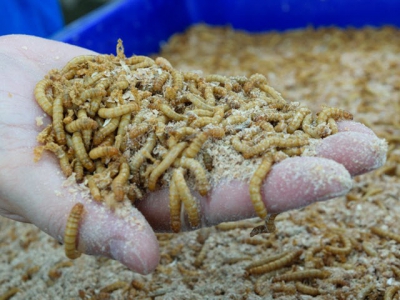Insect meal, oil show potential for partial fishmeal, oil replacement
Black soldier fly larvae-based oil and meal may boost trout production when fishmeal and fish oil are partially replaced, say researchers.
 Algae meals may support growth, body condition in carnivorous fish
Algae meals may support growth, body condition in carnivorous fish Swapping algae meal for portions of fishmeal, fish oil and plant proteins may provide similar growth performance and body condition in carnivorous fish
 Managing Cage Culture Systems
Managing Cage Culture Systems Fish may be produced at high density in cages suspended in private ponds or in State waters. Most aquaculture species can be produced in cages
 Channel Catfish Virus Disease
Channel Catfish Virus Disease Channel catfish virus disease (CCVD) was first recognized as a disease problem during the early days of commercial catfish farming
 Nitrite problem in Freshwater Fish Aquaculture and its control strategies
Nitrite problem in Freshwater Fish Aquaculture and its control strategies Nitrite enters a fish culture system after feed is digested by fish and the excess nitrogen is converted into ammonia, which is then excreted as waste
 Bacillus probiotics benefit tilapia rearing under challenging conditions in Brazil
Bacillus probiotics benefit tilapia rearing under challenging conditions in Brazil Since floating cages are the most common rearing method for tilapia in Brazil, they were used for the study at the Jaburu Farm in the Castanhão water reservoir.
 Reducing digestible protein in pond production of hybrid striped bass
Reducing digestible protein in pond production of hybrid striped bass There is growing interest to reexamine hybrid striped bass (HSB) feed formulas and nutrient requirements to maximize production efficiency
 Land-use efficiency study puts aquaculture on a pedestal
Land-use efficiency study puts aquaculture on a pedestal With mounting pressure on natural resources, NCEAS compares fish farming to terrestrial agriculture
 Predicting parasite outbreaks in fish farms through environmental DNA
Predicting parasite outbreaks in fish farms through environmental DNA Diseases are a major impact on, and represent one of the major constraints to future growth of, the aquaculture sector.
 Evaluating commercial, dietary pre-, pro- and synbiotics in hybrid catfish
Evaluating commercial, dietary pre-, pro- and synbiotics in hybrid catfish Aquaculture is currently the fastest growing food production sector in the world. High disease losses and pressures to find alternatives to antibiotics
 Research delves into enrichment of live feed for larval fish
Research delves into enrichment of live feed for larval fish The initial goal of the two-year grant is to improve the feed for, and therefore the production of, California yellowtail and halibut.
 A look at phospholipids in aquafeeds
A look at phospholipids in aquafeeds Phospholipid is a general term that includes all lipids containing phosphorus. However, it is a term often mistakenly equated with phosphoglycerides
 Fish oil alternatives are waiting in the wings
Fish oil alternatives are waiting in the wings New F3 oils challenge aims to accelerate development, adoption of critical aquafeed substitute
 Commercial demonstration of in-pond raceways
Commercial demonstration of in-pond raceways The In-Pond Raceway System (IPRS) is a fish culture technology developed to increase production efficiency and yield. This is a view of some of the IPRS raceway
 Amino acid supplementation reduces protein levels in pangasius diets
Amino acid supplementation reduces protein levels in pangasius diets Ongoing research with various fish species has shown that balancing the amino acid profiles of diets with free amino acids can be an effective strategy
 Feeds containing melanoidins may support trout production
Feeds containing melanoidins may support trout production The use of feed ingredients with melanoidins may not have negative effects on the production of farmed rainbow trout & may support fish digestion & performance
 Challenges replacing fishmeal in certain farmed fish diets
Challenges replacing fishmeal in certain farmed fish diets The use of soybean meal to replace fishmeal in the diets of farmed Totoaba may be limited, say researchers.
 Artificial upwelling maintains favorable summer environment for farmed oysters
Artificial upwelling maintains favorable summer environment for farmed oysters Pushing colder, nutrient-rich bottom water toward surface layers promotes circulation in the water column
 How to make the fish farming industry more climate friendly
How to make the fish farming industry more climate friendly A new Master’s thesis shows that a renewable wind and solar energy solution can cut emissions by 50 per cent and at the same time increase profitability.
 Evaluating Nannochloropsis-based feeds for tilapia
Evaluating Nannochloropsis-based feeds for tilapia Nutritional assessment shows adequate growth, survival, FCR and enhanced EPA levels. Evaluating Nannochloropsis-based feeds for tilapia
